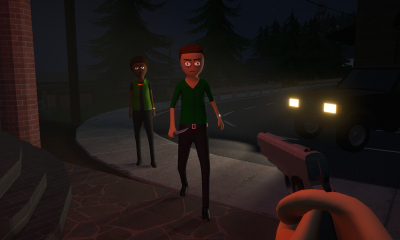My Initial Encounter
Stepping into the world of Schedule I Game was like entering a realm of unexpected vibrancy and intricate layers. I remember turning on my console on a rainy evening, curious about the rave reviews I had seen online. The cover art alone, with its dynamic interplay of light and shadow, beckoned me into an experience that promised both depth and fluidity. With a mix of excitement and apprehension, I dove into the immersive environment that the developers had so meticulously crafted.
Exploring a Rich and Dynamic World
One of the highlights of my journey was the world design. The scenery felt alive, and every corner held secrets waiting to be discovered. I wandered through bustling digital metropolises, quiet hidden sanctuaries, and surreal dreamscapes that defied the limitations of reality itself. The environment pulsed with energy—each district resonated with its own rhythm and personality, making exploration feel like a personal adventure. I found myself pausing frequently to admire the artful composition of hues and textures that brought every street, sky, and structure to life.
The Fluidity of Gameplay Mechanics
What struck me most was the gameplay flow. The mechanics are designed to be intuitive, as if the game itself adapts to your pace and style. Every action I took felt fluid and natural. Whether I was navigating challenging puzzles, engaging in dynamic strategy segments, or interacting with the environment in innovative ways, the controls responded with precision and grace. There were moments when the game seemed to know exactly what I needed to experience next, deepening the overall immersion. I truly appreciated the balance between challenge and exploration, where every task became a small triumph.
Refined Interactive Elements
In my experience, the interactivity was taken to a level that many modern titles try to achieve but seldom master. I was impressed by how small decisions and seemingly insignificant choices translated into tangible differences in the gameplay experience. The environment wasn't merely a backdrop—it was a character in its own right, reacting to my actions in subtle yet noticeable ways. Whether unlocking hidden pathways or initiating special events, each interaction contributed to a sense of progress and accomplishment.
A Visual Feast for the Eyes
Visually, Schedule I Game is a masterpiece. The art direction combines realistic textures with stylized elements that create an atmosphere both gritty and fantastical. Every scene is crafted with a clear narrative in mind, and the visual storytelling is deeply intertwined with the gameplay. During my exploration, I spent significant time admiring the care put into layering atmospheric details. The lighting, in particular, plays an essential role; as day turns into night, the subtleties in shadow and color shift dramatically, further enhancing the sense of immersion.
The Soundscapes and Musical Undertones
Accompanying the visual artistry is a soundscape that captivates the senses with its balance of ambient music and intricate sound effects. The background score is both haunting and uplifting, perfectly synchronized with the emotional undertones of the narrative. I marveled at how audio cues would sometimes guide my actions, hinting at hidden dangers or treasures. In combat sequences and high-intensity moments, the music would surge to accompany rising tension, reinforcing the feeling that I was truly a part of a vast, living system.
Complex Characters and Interactive Narratives
The characters I encountered were far from one-dimensional. Each individual in the game carried their own history, ambitions, and hidden layers that revealed themselves through subtle dialog and key interactions. I found the narrative to be interwoven with personal stories and broader societal themes, all delivering a rich tapestry of human experience set against fantastical backdrops. The voice acting was superb, creating moments of levity, tension, and deep emotion that rivaled the visual storytelling on display.
Adventure Through Innovative Challenges
Adventure in Schedule I Game is defined by creative challenges that test both reflexes and lateral thinking. I spent countless hours immersed in puzzles that adapted based on my previous choices, making each playthrough slightly different. The game expertly blends physical dexterity challenges with brain-teasing obstacles, ensuring that I was constantly engaged. There is a sense of wonder in overcoming a challenge that requires ingenuity rather than mere memorization of patterns or repeated attempts, and each success was rewarding and built on the layers of the game’s meticulously constructed world.
The Balance of Art and Strategy
One aspect that stood out to me was how well the art of subtle strategy was woven into the gameplay. Beyond being a platform for exploration and combat, the game contains myriad layers of strategy that I could sink my teeth into. I enjoyed devising methods to optimize my approach, whether that meant rethinking route choices in dense environments or adjusting my tactics during high-intensity moments. The strategic depth encouraged me to think several steps ahead, and in doing so, it elevated my engagement as I subconsciously planned each move.
Dynamic Social Interactions and Community Driven Moments
The digital communities within Schedule I Game are not mere optional extras—they are integral to the overall experience. As I progressed, I encountered various digital personalities that each had distinct viewpoints, often leading to interactive narrative experiences that felt both spontaneous and well-crafted. I cherished the moments when NPCs would share lore or give hints about hidden challenges in the game. Their interactions contributed to an evolving narrative that began to echo the style of a living, breathing world. The game's ability to mimic this level of community interaction made me feel like I was never truly alone in the sprawling digital realm.
Intricate Engineered Systems and Their Interplay
Delving deeper, I found that the heart of Schedule I Game lies in its carefully engineered systems. The way the various systems interacted created a game that was more than the sum of its parts. From the physics engine that made every collision and movement feel grounded in realism to the intricate AI that felt almost unpredictable yet fair, every component worked together harmoniously. This inter-system coordination has a way of drawing you further into the game, as you begin to appreciate the balance that exists between environmental factors and player actions. It is thrilling to see each system contribute to a coherent gaming experience where you are constantly aware of the organic interplay happening beneath the surface.
Examining the User Interface and Control Customization
As someone who occasionally struggles with clunky interfaces, I was pleasantly surprised by the user-centric design of Schedule I Game. Navigating menus and customizing controls was streamlined, with thoughtful placement of options ensuring that everything remained accessible. My experience was enhanced by the responsive design; every press, swipe, or click caused the interface to react instantly. The customization options allowed me to adjust the control settings and visual elements to suit my personal preferences, which in turn made the game even more intuitive. I found it refreshing to see an interface that bridges the gap between artistic expression and functionality, letting me focus on the game rather than the controls.
Personal Growth and Artistic Expression
Another layer that resonated with me was the way my journey within the game paralleled the artist’s own process of expression. Every decision I made, every unexplored path, contributed to an evolving narrative that reflected personal growth. I observed subtle changes in the game environment that mirrored the passage of time, both within the storyline and in my own progression as a player. The developers have embedded an addictive sense of discovery by letting art and gameplay converge, thereby creating a space where emotion and strategy exist side by side. I spent many hours introspecting on how the evolving narrative allowed me to express a facet of my inner self that is rarely tapped in everyday life.
Exploring the Depths of Customization and Player Identity
Customization within Schedule I Game is not limited to aesthetics. While I relished the ability to adjust the appearance of my in-game character, the game goes further by letting me shape my narrative journey. Character evolution is intertwined with choices I made earlier, which meant that every customization option could lead to drastically different outcomes. I found it liberating to tailor my journey not merely at a surface level but also in the nuanced interplay of personality traits and skills. The extensive customization options allowed me to create a version of myself that was both a reflection of my gaming style and a departure from conventional archetypes. The sense of identity that emerged from this personalized experience was one of the most fulfilling aspects of my adventure.
My Interaction With the Challenge Design
The challenge design in Schedule I Game is something that frequently kept me engaged, pushing me to explore my own limits. I experienced encounters that were as intellectually demanding as they were visually captivating. The tasks varied from logical puzzles to fast-paced segments that required me to strategize on the fly. The balance maintained between these different types of challenges was key to sustaining my interest over long periods. Each new level or scenario felt like a fresh puzzle that required a unique line of thinking, which kept the enjoyment level high and continually renewed my sense of anticipation for what was coming next.
An Unconventional Approach to Narrative Integration
Another element that I deeply appreciated was the unconventional narrative integration. Rather than relying on simplistic plot devices, Schedule I Game incorporates subtle hints, environmental storytelling, and layered character dialogues to reveal its backstory. As I navigated through diverse settings, I found that stories were embedded in every wall, every piece of ambient sound. It felt as though the world itself was whispering hints of its history. The narrative did not come at the expense of gameplay; instead, it elevated the entire experience by creating a cohesive tapestry that encouraged critical thought and curiosity. I often paused long after hearing a particularly evocative piece of dialogue or stumbling upon a relic that hinted at a larger history.
Diving into the Multifaceted Combat Experience
Although the game is not solely defined by combat, there are moments when the action sequences take center stage. I was pleasantly surprised by the layers of depth present in these encounters. The combat system integrates timing, precision, and strategic positioning in a way that feels both accessible and rewarding. Each confrontation felt like an intricate dance where my timing had to sync perfectly with the digital rhythm of the game. The fluidity of the combat mechanics contributed to an overall sense of empowerment; I found myself eagerly anticipating the next challenge and relishing in every small victory that each encounter provided. I made it a point to experiment with different strategies, learning that each enemy or scenario could be approached in several creative ways.
Unraveling the Technical Brilliance
The seamless performance of Schedule I Game is a testament to its sophisticated technical design. I was particularly impressed with the smooth transitions between scenes and the minimal load times, which allowed me to remain immersed in the narrative and gameplay. Despite the complex systems running under the hood, the game rarely exhibited signs of lag or disruption. The technical polish is evident in every aspect—from the natural fluidity of character movements to the harmonious synchronization of visual and audio elements. I found that the game’s engine provides a stable yet dynamic framework that can handle the evolving demands of an expansive digital world. Every interaction, be it a delicate maneuver or a challenging strategic encounter, was executed with surprising resilience and precision.
The Amalgamation of Storytelling and Creative Freedom
Schedule I Game offers a compelling blend of storytelling and interactive creativity. Throughout my experience, I found that every element of the game, whether it was the carefully constructed dialogues, the ambient settings, or the rich customization options, contributed to a larger narrative fabric that felt alive and evolving. This amalgamation has crafted an interactive journey where personal creativity and a well-thought-out narrative coalesce. I appreciate a game that does not confine itself to linear storytelling. Instead, it encourages exploration and experimentation in ways that challenge my perceptions while rewarding my curiosity. My journey through this game became not just an adventure but also a continuous process of self-expression and exploration.
Trending games
-
![Fortnite logo]() Fortnite
Epic Games
Fortnite, developed by Epic Games, emerged from relative obscurity to become a gaming sensation that transcended entertainment and permeated popular...
Fortnite
Epic Games
Fortnite, developed by Epic Games, emerged from relative obscurity to become a gaming sensation that transcended entertainment and permeated popular...
-
![Grand Theft Auto V logo]() Grand Theft Auto V
Rockstar Games
Grand Theft Auto V is the latest part of the famous GTA series developed by Rockstar. The game was initially...
Grand Theft Auto V
Rockstar Games
Grand Theft Auto V is the latest part of the famous GTA series developed by Rockstar. The game was initially...
-
![Minecraft logo]() Minecraft
Mojang
Minecraft is a sandbox construction game, made by the Swedish company Mojang. Minecraft is created in a 3D environment and...
Minecraft
Mojang
Minecraft is a sandbox construction game, made by the Swedish company Mojang. Minecraft is created in a 3D environment and...
-
![Roblox logo]() Roblox
Roblox Corporation
Roblox is a sandbox game platform, where users can create game modes and servers and enjoy the community-created content. It...
Roblox
Roblox Corporation
Roblox is a sandbox game platform, where users can create game modes and servers and enjoy the community-created content. It...
-
![Geometry Dash logo]() Geometry Dash
RobTop Games
Geometry Dash is an action platformer game developed by RobTop Games. It was initially released on PC in 2013 and...
Geometry Dash
RobTop Games
Geometry Dash is an action platformer game developed by RobTop Games. It was initially released on PC in 2013 and...
-
![Poppy Playtime logo]() Poppy Playtime
MOB Games
In the ever-expansive domain of survival horror games, few have risen as meteorically or as unsettlingly as "Poppy Playtime." This...
Poppy Playtime
MOB Games
In the ever-expansive domain of survival horror games, few have risen as meteorically or as unsettlingly as "Poppy Playtime." This...
-
![Gacha Cute logo]() Gacha Cute
A Whole New World of Adorable Characters and Addictive Gameplay Awaits!
Hey there, fellow lovers of all things cute and...
Gacha Cute
A Whole New World of Adorable Characters and Addictive Gameplay Awaits!
Hey there, fellow lovers of all things cute and...
-
![Gacha Nox logo]() Gacha Nox
Imagine stepping into a world adorned in warm and soft pink hues, buzzing with customization options galore–welcome to the stand-out...
Gacha Nox
Imagine stepping into a world adorned in warm and soft pink hues, buzzing with customization options galore–welcome to the stand-out...
-
![Garten of Banban 4 logo]() Garten of Banban 4
An Immersive Dive into Garten of Banban 4
Garten of Banban 4 offers a refreshing twist to the unconventional gaming...
Garten of Banban 4
An Immersive Dive into Garten of Banban 4
Garten of Banban 4 offers a refreshing twist to the unconventional gaming...
-
![Hole.io logo]() Hole.io
Immersing in the World of Hole.io
Stepping into the arena of Hole.io as an experienced gamer, I have come to...
Hole.io
Immersing in the World of Hole.io
Stepping into the arena of Hole.io as an experienced gamer, I have come to...



























